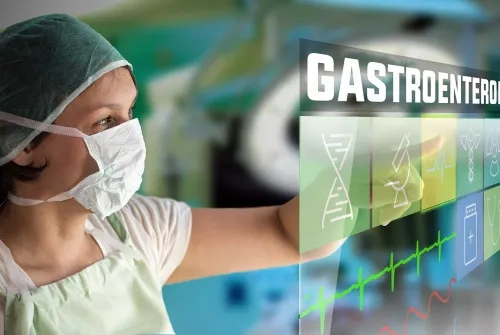Alo Yeditepe
Alo Yeditepe
Techniques and Applications Used in Gastroenterology
Endoscopic Ultrasonography (EUS)
It was created by attaching an ultrasonography probe to the end of a conventional endoscope. It has started to be utilized more and more commonly in gastroenterology due to the improving image quality. It is one of the most complex technical procedures in gastroenterology and should only be carried out by specialists who have received endoscopic and ultrasonography training.
Endoscopic ultrasonography provides highly accurate information on the extent of a lesion seen during endoscopy, as well as if it has migrated to nearby organs and whether lymph nodes are involved. Samples from the lesion can be collected.
While it is extremely difficult to diagnose tumors, particularly those of the pancreas and biliary tract, collecting samples allows for clearer images and pathological diagnosis.
In appropriate patients, advanced-stage pancreatic cancers are treated by injecting chemotherapy drugs into the tumor.
Severe abdominal pain that does not respond to treatment in patients with pancreatic cancer or advanced pancreatitis is also treated internally to the nerves in that area with this method, ensuring that the patient's pain is relieved.
Endoscopic ultrasonography is also very useful in the diagnosis of pancreatic cysts. Since pancreatic cysts can be malignant or benign, EUS is critical in distinguishing them, and cyst fluid analysis can detect malignant cells that may be present.
This cyst fluid can be drained by EUS examination and a stent can be placed in this area to treat pseudocysts caused by pancreatitis.
Aside from that, under external pressure, EUS can see and diagnose tumors in the esophagus, stomach, and duodenum. A prominent example of these is GISTs (Gastrointestinal Stromal Tumors), which have shown an increase in diagnoses in recent years. These tumors develop in the muscular layer that lies beneath the mucosa that protects organs like the stomach. As a result, it is impossible to comprehend what occurs during a typical endoscopy. The genesis of these formations in the stomach, their internal structure, size, and relationship to neighboring tissues can all be seen with EUS. It is even possible to perform a biopsy when required. EUS can therefore spare many patients from undergoing unneeded procedures.
Uses of Endoscopic Ultrasonography
- Diagnosis and staging of esophageal gastric and rectal tumors
- The evaluation of abnormal structures of the gastrointestinal wall or adjacent structures (masses originating from under the gastric wall, external compression)
- Thickening of the stomach wall
- The staging and biopsy diagnosis of pancreatic cancers
- Examination of pancreatic diseases (Suspicious masses, cystic lesions, pancreatitis)
- Diagnosis of stones and tumors in the bile duct
- Celiac blockade to prevent pain due to pancreatic cancer
ERCP
The ERCP (Endoscopic Retrograde Cholangiopancreatography) procedure is used to cure jaundice brought on by obstruction, remove stones from the gallbladder that have entered the bile ducts, and identify malignancies in the bile ducts. ERCP is a lengthy and exhausting procedure that can be carried out by specialists in this field. Among endoscopic treatments, it carries one of the highest risks for complications. As a result, it is a procedure that should only be performed by gastroenterologists with experience.
Almost 10% of the population has gallbladder stones. Most individuals never experience any symptoms from these stones throughout their lifetime. Nonetheless, in certain cases, it might result in gallbladder inflammation. Gallstones can occasionally reach the bile duct and obstruct the flow of bile, which can result in jaundice, fever, and excruciating stomach discomfort. In this instance, ERCP is used to remove the stones. In some conditions, stones can obstruct the pancreatic duct and result in pancreatitis.
The ERCP operation is performed by entering orally through the second half of the duodenum, where the biliary system is accessed, using a tool akin to an endoscope. Once reached, the bile duct is checked before the biliary tract is accessed. Following this step, a few millimeters are removed to widen the canal's mouth. Then, stones are eliminated using a balloon or basketball-shaped implements. It is a successful treatment that produces results fairly rapidly when the proper patient and the right rationale are selected for the procedure.
Inflammation of the pancreatic gland, which happens between 2 and 5% of the time following ERCP, is the main side effect. Even while it is usually moderate in patients, it can occasionally be severe. There are many methods for preventing this problem, including using drugs or stents. The practitioner may prefer one of these methods. In addition to this, it is possible to observe bleeding and intestinal perforation while creating an incision. The patient should be rushed to emergency surgery in these circumstances. One in 1000 people, however, experience these complications.
The ERCP procedure is applied significantly differently in pregnant women since it uses radiation. ERCP can be performed during pregnancy without filming if an incision is made, stones are removed with a balloon, or a temporary stent is inserted in the bile ducts. When the pregnancy ends, permanent treatment is performed.
It is suitable for the patient to undergo gallbladder surgery for long-term treatment after the ERCP is completed and the bile duct stones have been removed.
This content was prepared by Yeditepe University Hospitals Medical Editorial Board.
”
See Also
- What is a Liver Transplant, How is it Done? and Who is it For?
- What is Constipation? What Helps With Constipation?
- What is Hepatitis B? What are its symptoms? How is it Transmitted?
- How to Cleanse the Liver the Fastest?
- Who Gets Colon Cancer?
- What is Colostrum? What are the Benefits of Colostrum Milk?
- Stomach Cancer Causes, Symptoms and Treatment
- What is Colon (Intestinal) Cancer? Symptoms and Treatment
- What Causes Nausea? What is Good for Nausea?
- What is Heartburn? What is Good for Heartburn?
- What is Fatty Liver?
- What is Good for Diarrhea? How to Treat Diarrhea?
- What is a Probiotic? What Are Its Benefits?
- What Is Reflux?
- Non-Surgical Treatment of Reflux
- What are the Nutrients That Stress Digestion?
- What are Capsule Treatment Methods in Stomach, Small, and Large Intestine Screening?
- Gastroenterology Procedures
- Pay Attention When Consuming These Nutrients!
- Mediterranean Diet Prevents Developing Colon Cancer!
- Breakthrough Innovations in Colon Cancer
- Diarrhea and Constipation Increased in Those with Irritable Stomach
- I Was Waking Up With Stomach Pain, I Fell Better After Endoscopic Fundoplication
- Anemia, Constipation, and Vomiting of Unknown Cause Can Be Dangerous
- As the Western Diet Increases, So Does Stomach Cancer
- Ramadan Warning for Those Who Experience Stomach Disorders
- Causes and Treatment of Abdominal Bloating
- Hepatitis Disease Poses Risk for Esophageal Varices
- The Giant Stones In The Biliary Tract Of 71-Year-Old Patient Were Removed Without Surgery
- How Is Stomach Infection Transmitted?
- What is Gastroesophageal Reflux Disease?
- Capsule Endoscopy
- Stretta / Endoscopic Reflux Treatment
- Fundoplication Method / Endoscopic Reflux Treatment
- Throat Reflux
- Irritable Bowel Syndrome (IBS)
- How to Swallow the Drug?
- Non-Surgical Reflux Treatment
Alo Yeditepe





